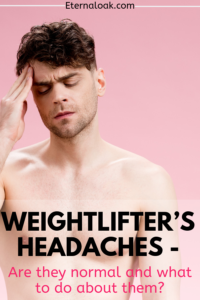Do you ever get struck with a splitting headache right when you’re in the middle of blasting through your weightlifting routine? This is actually a surprisingly common problem among weightlifters.
Here’s what you can do to address the problem and get back to focusing on your workouts.
Table of Contents
Why am I getting headaches when I lift?
Is your head aching after just a few lifts? Don’t worry, this usually is not a sign of any major issue. This type of headache is technically referred to as an “exertion headache.”
Dr. MaryAnn Mays explains that more blood begins circulating throughout the head when you workout, and this sudden boost in blood volume can trigger a headache (1).
Common headache symptoms during lifting
Most people who report headaches while weight lifting share these key symptoms”
- Pain that starts during or after exercise
- A throbbing sensation
- Sensations of squeezing discomfort around the head
- Pain on either one or both sides of the head
- Discomfort that lasts up to two days
It is possible for people to encounter other symptoms like vomiting, a stiff neck, double vision, dizziness, or loss of consciousness, but these are rare.
Causes of headaches during lifting
There are all sorts of causes for headaches during lifting. Some can be fairly harmless causes while others can be major medical issues. Here are a few potential reasons for your headache.
- Perfectly normal changes to blood flow are triggering a headache.
- You are getting dehydrated from your workout.
- Exercise can trigger migraines in those who frequently get these headaches.
- You have a sinus infection that is putting pressure on your head during exercises.
- Low blood sugar may cause headaches
- A tumor is putting pressure on part of your head.
- You have a hemorrhage, coronary artery disease, or other cardiovascular issue affecting blood flow during exercise.
Should I workout if I have a migraine?
So what should you do if you start getting migraines during your workout? The good thing is that regular exercise can actually decrease the severity of your migraines according to Dr. Lawrence Newman (2).
If your headache isn’t horrible, you may be able to continue doing light lifts.
However, trying to power through a severe migraine isn’t a good idea. You need to be focused and energized to avoid hurting yourself during heavy lifts.
So if your migraine is causing nausea, blurred vision, or auras, you should probably skip the gym for the day.

Are exertion headaches dangerous?
Whether or not the headache is dangerous depends on the cause. These types of headaches are divided into two categories, primary exertion headaches and secondary exertion headaches.
A primary exertion headache is just caused by the body’s reaction to sudden exercise. It is not dangerous, and you will not notice any symptoms besides a headache.
A secondary exertion happens when you have some underlying condition, like a hemorrhage, and exercise makes the issue get so bad that you develop a headache. These can be quite dangerous.
How long do exertion headaches last?
Everyone is different, so there is no way of predicting how long your exertion headache will last. Some people’s headaches may go away after five minutes.
Others may have a headache for a couple hours following the onset. Since exercise headaches can take a few hours to start after weightlifting, this may mean your head aches for the rest of the day.
If you are one of the unfortunate people who have migraines triggered by weightlifting, it may last even longer. In these cases, the headache may not go away entirely for up to two days.
4 ways to prevent exertion headaches
Follow these tips to try to cut back on how often you get exertion headaches.
Take it slow. Often, an exertion headache is your body’s response to sudden, intense exercise.
Warming up and starting with easier lifts can help gradually increase blood pressure and heart rate, so you are not as likely to suddenly get a headache.
Stay hydrated. Often, people think they have an exertion headache when they’re really dealing with plain old hydration problems.
Be sure to drink plenty of water in the hours leading up to your gym session, so you can make sure your body is fully hydrated by the time you start.
Have a snack a few hours before. This ensures you do not suffer from a blood sugar crash.
Snacking before weightlifting is also linked to increased performance, so it’s always a good idea (3).
Prepare for exercise correctly. Always wear the correct clothing, get plenty of sleep, and exercise in a comfortable environment.
Things that help you avoid overwhelming and stressing your body will assist with headache prevention.
5 ways to treat exertion headaches
Fortunately, you do not just have to give up and suffer from headaches. Taking a break from exercise can work, but if you talk to your doctor, you can get more effective treatments.
Here are a few of the most common medications and remedies that can stop a headache in its tracks.
- Over the counter painkillers
- Indomethacin or other an anti-inflammatory prescription drug
- Propranolol and other blood pressure medications
- Sports drinks with electrolytes
- Naproxen and other NSAIDs
When is it a concern and when to see your doctor?
In most cases, a headache while weightlifting is fairly normal and not a cause for concern.
However, it’s always good to bring up exertion headaches with your doctor if you’ve never had them before and are suddenly experiencing them during weightlifting.
You especially need to get checked out if your headache causes a rigid neck, double vision, dizziness, nausea, vomiting, or a loss of consciousness. These can be a sign that something serious is a problem.
Sources
(1) https://health.clevelandclinic.org/how-you-can-stop-headaches-from-derailing-your-workouts/
(2) https://www.menshealth.com/health/a24398589/should-you-exercise-with-a-migraine/